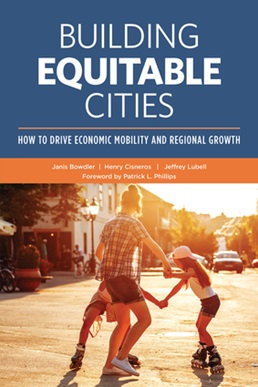Building Equitable Cities

How to Drive Economic Mobility and Regional Growth
How can cities promote economic mobility, advance equity, and drive growth? This book provides real-world examples of both place-based and people-based strategies that are being used successfully to provide more equitable outcomes. See how local government and business leaders are working together to improve services in underserved neighborhoods, to add affordable housing to neighborhoods with high-quality services, and to strengthen education, workforce, and financial outcomes for all – and how these efforts are paying off in terms of economic growth for the region. In addition to benefiting from the sharing of lessons learned, readers will come away with replicable tools, techniques, and processes. Through an analysis of best practices, proven policies, and case study examples, you will get practical insights into how your community can expand opportunities for more citizens and boost economic expansion.
In addition to this practical guidance on how to promote economic mobility, this book also provides suggestions for how cities can develop a strategic plan for promoting this mobility as part of a broader equity agenda, along with the operational infrastructure needed to advance that plan. While a growing number of cities are focusing explicitly on an equity agenda and some have appointed chief equity officers, no city government in the United States today has created an overarching equity umbrella and assembled under it the myriad governmental and independent efforts involved in equity programs. It is a city leadership task that can be achieved.
Book Summary: How can cities promote economic mobility, advance equity, and drive growth? This book provides real-world examples of both place-based and people-based strategies that are being used successfully to provide more equitable outcomes. See how local government and business leaders are working together to improve services in underserved neighborhoods, to add affordable housing to neighborhoods with high-quality services, and to strengthen education, workforce, and financial outcomes for all – and how these efforts are paying off in terms of economic growth for the region. In addition to benefiting from the sharing of lessons learned, readers will come away with replicable tools, techniques, and processes. Through an analysis of best practices, proven policies, and case study examples, you will get practical insights into how your community can expand opportunities for more citizens and boost economic expansion.
In addition to this practical guidance on how to promote economic mobility, this book also provides suggestions for how cities can develop a strategic plan for promoting this mobility as part of a broader equity agenda, along with the operational infrastructure needed to advance that plan. While a growing number of cities are focusing explicitly on an equity agenda and some have appointed chief equity officers, no city government in the United States today has created an overarching equity umbrella and assembled under it the myriad governmental and independent efforts involved in equity programs. It is a city leadership task that can be achieved.


